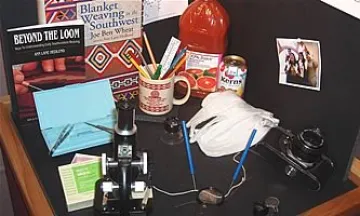
A selection of items used in textile analysis. The juices here (Kern’s Guava Juice and Safeway Cranberry Juice) contain carmine food coloring. Photo by Ann Hedlund.
Scientists and weavers today identify and date textiles through analysis of fibers, dyes, yarn composition, and weave structure. Magnifiers of many kinds assist in identifying the fibers and structures. Notes are made on standardized forms and in computer databases.
Dyes are studied through spectrophotometry—the study of light waves as they are tranmitted through colored liquids extracted from the dyestuffs—and other tests. The red insect dyes—cochineal and lac—and some synthetic dyes each produce a characteristic curve when their specturm is graphed. Different mixtures of these dyes also have recognizable "fingerprints."
Carmine, the red chemical in cochineal dye, is used today as food coloring.





